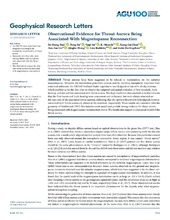Observational evidence for throat aurora being associated with magnetopause reconnection
Han, De-Sheng; Xu, Tong; Jin, Yaqi; Oksavik, Kjellmar; Chen, Xiangcai; Liu, Jian-Jun; Zhang, Qinghe; Baddeley, Lisa; Herlingshaw, Katie
Peer reviewed, Journal article
Published version

Åpne
Permanent lenke
https://hdl.handle.net/1956/22287Utgivelsesdato
2019Metadata
Vis full innførselSamlinger
Originalversjon
https://doi.org/10.1029/2019gl083593Sammendrag
Throat auroras have been suggested to be related to indentations on the subsolar magnetopause. However, the indentation generation process and the resulting ionospheric responses have remained unknown. An EISCAT Svalbard Radar experiment was designed to run with all‐sky cameras, which enabled us for the first time to observe the temporal and spatial evolution of flow reversals, Joule heating, and ion upflows associated with throat aurora. The high‐resolution data enabled us to discriminate that the flow bursts and Joule heating were concurrent and co‐located, but were always observed on the west side of the associated throat auroras, reflecting that the upward/downward field‐aligned currents associated with throat aurora are always to the east/west, respectively. These results are consistent with the geometry of Southwood (1987) flux transfer event model and provide strong evidence for throat aurora being associated with magnetopause reconnection events. The results also support a conceptual model of the throat aurora.